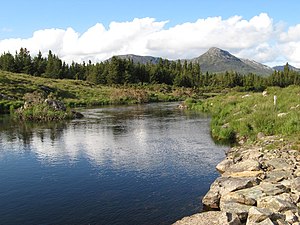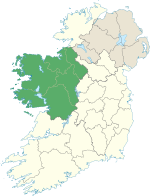Benglenisky


Benglenisky (Irish: Binn Ghleann Uisce, meaning 'Peak of the Glen of the Water')[2] at 516 metres (1,693 ft), is the 368th–highest peak in Ireland on the Arderin scale.[3][4][5] Benglenisky is the second most southern peak, after neighbouring Benlettery, of the Twelve Bens mountain range in the Connemara National Park in County Galway, Ireland, and is the lowest of the core Twelve Bens.[5][6]
Naming
According to Irish academic Paul Tempan, Irish: Gleann Uisce, meaning "the glen of water", is from the glen on the south-east side of this peak. Tempan also notes that on the north-west side in the townland of Irish: Barr na nÓrán, Benglenisky is known as Irish: Binn Dubh (meaning "Black Peak") or Irish: Cnoc Dubh (meaning "Black Hill").[2] The green Connemara marble is quarried in Barr na nÓrán, which was first started by Thomas Barnwall Martin in the 1820s.[2]
Geography
Benglenisky is the second southernmost peak of the Twelve Bens after Benlettery 577 metres (1,893 ft), and lies at the western edge of the range.[7]
Benglenisky is connected to the range by a high north-easterly ridge to the peak of Bengower 664 metres (2,178 ft);[5] this ridge forms a fork which also connects neighboring Benlettery to Bengower.[7][5] Benglenisky sits off the main ridge of the six Bens that form a horseshoe around the valley of the Glencoaghan River (also known as the Glencoaghan Horseshoe), and is thus less frequented.[8][9]
Benglenisky is the lowest of the core Twelve Bens, and only meets the mountain classification of an Arderin.[5] Its relative positioning at the southern end of the range, jutting out on its own ridge, means that it often appears as a scenic backdrop to Ballynahinch Castle and the Ballynahinch Lake, however, it is still overshadowed by its more dramatic neighbour, Benlettery, with its striking "pyramidal" profile.[10]
Hill walking
As with Benlettery, Benglenisky's accessibility means that it can be summited as a standalone 5-kilometre 2-3 hour climb (starting and ending at the Ben Lettery An Oige youth hostel); however, the high ridge Benglenisky shares with the peaks of Bengower and Benlettery, means that it is also climbed as part a 7-kilometre 3-4 hour horseshoe loop-walk with these peaks.[10][11][12]
Benglenisky does not feature on the core route of the more famous 16–kilometre 8–9 hour Glencoaghan Horseshoe, considered one of Ireland's best hill-walks;[8][9] or the even longer Owenglin Horseshoe, a 20–kilometre 10–12 hour route around the Owenglin River taking in over twelve summits.[7]
Gallery
-

-
 Benlettery (right) and Benglenisky (left), from the Owenmore River
Benlettery (right) and Benglenisky (left), from the Owenmore River -
 Benlettery (left) and Benglenisky (right) from summit of Bengower
Benlettery (left) and Benglenisky (right) from summit of Bengower
Bibliography
- Fairbairn, Helen (2014). Ireland's Best Walks: A Walking Guide. Collins Press. ISBN 978-1848892118.
- MountainViews Online Database (Simon Stewart) (2013). A Guide to Ireland's Mountain Summits: The Vandeleur-Lynams & the Arderins. Collins Books. ISBN 978-1-84889-164-7.
- Paul Phelan (2011). Connemara & Mayo - A Walking Guide: Mountain, Coastal & Island Walks. Collins Press. ISBN 978-1848891029.
- Dillion, Paddy (2001). Connemara: Collins Rambler's guide. Harper Collins. ISBN 978-0002201216.
- Dillion, Paddy (1993). The Mountains of Ireland: A Guide to Walking the Summits. Cicerone. ISBN 978-1852841102.
See also

- Twelve Bens
- Mweelrea, major range in Killary Harbour
- Maumturks, major range in Connemara
- Lists of mountains in Ireland
References
- ^ a b c d "Benglenisky". MountainViews Online Database. Retrieved 31 July 2019.
- ^ a b c Paul Tempan (February 2012). "Irish Hill and Mountain Names" (PDF). MountainViews.ie.
- ^ Simon Stewart (October 2018). "Arderins: Irish mountains of 500+m with a prominence of 30m". MountainViews Online Database.
- ^ Simon Stewart (October 2018). "Vandeleur-Lynams: Irish mountains of 600+m with a prominence of 15m". MountainViews Online Database.
- ^ a b c d e Mountainviews, (September 2013), "A Guide to Ireland's Mountain Summits: The Vandeleur-Lynams & the Arderins", Collins Books, Cork, ISBN 978-1-84889-164-7
- ^ Dillion, Paddy (2001). Connemara: Collins Rambler's guide. Harper Collins. ISBN 978-0002201216.
- ^ a b c Dillion, Paddy (2001). Connemara: Collins Rambler's guide. Harper Collins. ISBN 978-0002201216.
Walk 24: Owenglin Horseshoe
- ^ a b Helen Fairbairn (30 December 2014). Ireland's Best Walks: A Walking Guide (Walking Guides). Collins Press. ISBN 978-1848892118.
ROUTE 34: The Glencoaghan Horseshoe. A true classic
- ^ a b Dillion, Paddy (2001). Connemara: Collins Rambler's guide. Harper Collins. ISBN 978-0002201216.
Walk 30: Gleann Chóchan Horseshoe
- ^ a b Dillion, Paddy (2001). Connemara: Collins Rambler's guide. Harper Collins. ISBN 978-0002201216.
Walk 23: Binn Ghleann Uisce
- ^ John G. O'Dwyer (29 October 2015). "A walk for the weekend: Twelve Bens, Connemara, Co Galway". Irish Times. Retrieved 9 August 2019.
- ^ Paul Phelan (2011). Connemara & Mayo - A Walking Guide: Mountain, Coastal & Island Walks. Collins Press. ISBN 978-1848891029.
Route 4: Benglenisky, Bengower and Benlettery
External links
- MountainViews: The Irish Mountain Website, Benglenisky
- MountainViews: Irish Online Mountain Database
- The Database of British and Irish Hills , the largest database of British Isles mountains ("DoBIH")
- Hill Bagging UK & Ireland, the searchable interface for the DoBIH
- v
- t
- e
















